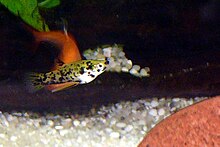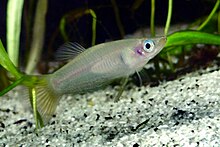Viviparous toothcarps
| Viviparous toothcarps | ||||||||||||
|---|---|---|---|---|---|---|---|---|---|---|---|---|

Guppies ( Poecilia reticulata ), one ♂ above , two ♀ below , wild form |
||||||||||||
| Systematics | ||||||||||||
|
||||||||||||
| Scientific name | ||||||||||||
| Poeciliidae | ||||||||||||
| Bonaparte , 1831 |
The viviparous toothcarps (Poeciliidae) comprise more than 270 species and some subspecies. As the name suggests, they are ovoviviparous , which means that they do not lay eggs, but rather give birth to their offspring alive. Mating takes place accordingly with internal fertilization .
Overview
The mostly quite small animals live mainly in fresh water , only a few species are found in brackish water . The fish are mostly up to a maximum of 10 cm long, depending on the species, the largest representative is the pike- fish ( Belonesox belizanus ), which reaches a body length of 20 cm. The representatives of the Poeciliidae family have economic importance on the one hand as mosquito killers , on the other hand as robust, beautifully colored and therefore popular aquarium fish . The use of viviparous toothcarps to control mosquitoes led to the fact that the fish originally native to tropical and subtropical America can now be found in almost all warmer regions of the world. The adaptability of the animals did the rest. Conversely, the original limitation of their occurrence to the American continent indicates that, in terms of developmental history, the viviparous toothcarps are quite a young family, which only developed after the separation of America from the other continents .
The differences between the sexes are very pronounced in viviparous toothcarps: the males are regularly a little smaller and much more vividly drawn than the females. The mating organ of the viviparous toothcarps is the gonopodium , an extension of the vas deferens to the outside. The gonopodium develops when the males are young. Mating takes place in such a way that the male storms the female and tries to bring the gonopodium close to the female sexual opening and finally to anchor it there. The very long-lived sperm remain in the female's body for a long time, so that one mating enables several litters.
It is claimed that viviparous toothcarps can undergo sex reassignment from female to male; in the swordtail ( Xiphophorus hellerii ) this was allegedly observed in individual cases. In no case is a conversion of a functional male into a functional female or vice versa proven. A “functional male” would be one who has demonstrably produced offspring; the term “functional female” is to be understood analogously. It can therefore be assumed that this “sex change” actually only corresponds to the observation of the development of so-called “late males” who simply develop their gonopodium relatively late.

In addition, the livebearer toothcarps impress with their versatility, not only in terms of their external appearance, but also in terms of their way of life. Live-bearing toothcarps are found in muddy pools as well as in clear, fast-flowing rivers. The fish are mainly carnivores: they prey on small insects or mosquito larvae on the surface of the water . They also eat algae or the leaf tips of aquatic plants .
Since the late 1990s there have been several species of this genus as invasive species in German waters. The first sighting was near Cologne (Guppybach source), meanwhile also in numerous other places. The animals were always illegally released there. The condition for survival in these places is always a water temperature that is over 18-20 degrees even in winter, which is often the case at the service water outflows of power plants and industrial plants where water is used for cooling, which is then heated in the Water is drained. This creates mini biotopes, usually less than 100 m long, where the fish can survive and even multiply.
Systematics
The live- bearing toothcarps were first described as a subfamily under the name Paecilini in 1831 by the Italian zoologist Charles Lucien Bonaparte . Fitzinger corrected the name to Poëcilioidei in 1831, Swainson to Poecilinae in 1838 and Garman to Poeciliinae in 1895.
Later the viviparous toothcarps were run as a separate family (Poeciliidae) alongside the egg-laying toothcarps (Cyprinodontidae). In a comprehensive revision of the toothcarps, the American ichthyologist Lynne R. Parenti placed the viviparous toothcarps together with the light-eyed fish in the family Poeciliidae, so that they became a subfamily again. However, they are more closely related to the Central and South American Anablepidae than to the African light-eye fish. That is why the viviparous toothcarps, like the luminous-eyed fish, became independent families in February 2018.
Genera
Phylogeny
The cladogram shows that Priapichthys is probably not a monophylum . |
literature
- Wolfgang Kochsiek: Practical Guide to Livebearers : Care, Breeding and Species, Ettingen 2011, ISBN 978-3-935175-68-5
- Joseph S. Nelson : Fishes of the World , John Wiley & Sons, 2006, ISBN 0-471-25031-7
- M. Kempkes, F. Schäfer: All livebearers , ACS, Mörfelden-Walldorf 2000, ISBN 3-931702-77-4
Individual evidence
- ^ Richard van der Laan, William Eschmeyer and Ronald Fricke: Family-group names of Recent fishes. Zootaxa 3882 (2): 001-230. doi: 10.11646 / zootaxa.3882.1.1 . Page 75.
- ^ LR Parenti (1981): A phylogenetic and biogeographic analysis of cyprinodontiform fishes (Teleostei, Atherinomorpha) . Bulletin of the American Museum of Natural History 168 (4): 335-557 January 1981
- ↑ Bragança, PHN, Amorim, PF & Costa, WJEM (2018): Pantanodontidae (Teleostei, Cyprinodontiformes), the sister group to all other cyprinodontoid killifishes as inferred by molecular data. Zoosystematics and Evolution, 94 (1): 137-145, doi: 10.3897 / zse.94.22173 .
- ↑ Huber, JH (2019): A nomenclatural and systematic Analysis of livebearing Cyprinodontiformes (Acanthopterygii: Anablepsinae, Goodeinae, Poeciliidae). Killi-Data Series 2019: 4-155, 3 tabs., 8 figs.
- ↑ David N. Reznick, Andrew I. Furness, Robert W. Meredith, Mark S. Springer (2017): The origin and biogeographic diversification of fishes in the family Poeciliidae. PLoS ONE 12 (3): e0172546. doi: 10.1371 / journal.pone.0172546
Web links
- Livebearers on Fishbase.org (English)
- http://www.dglz.de - German Society for Livebearers Toothcarps
- http://www.lebendgebaerende-aquarienfische.de - Information on the wild forms of viviparous toothcarps (VDA working group)
- Ethological and morphological studies on the reproduction of Heterandria formosa (Teleostei; Poeciliidae) - diploma thesis


